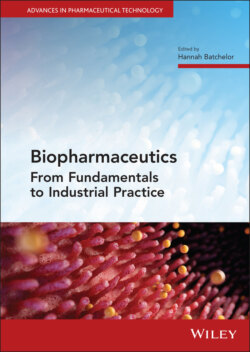Читать книгу Biopharmaceutics - Группа авторов - Страница 31
2.7.2 Excretion
ОглавлениеMost of the drug (unchanged and its metabolites), along with other metabolic wastes that are produced in the body as part of the daily routine, are excreted in urine via the kidneys. Renal excretion, therefore, is considered as the prime route of elimination for many drugs. The kidney receives about a quarter of the cardiac output; ~1.25 L blood flows through kidneys every minute. The renal tubule is the unit structure in the kidney that is responsible for filtering the drug, metabolites and other wastes, and is also referred to as nephron. There are hundreds of thousands of nephrons present in each kidney. The drug and metabolites along with other waste products are filtered at the glomerulus that is a bunch of blood capillaries twisted into Bowman’s capsule in each nephron (Figure 2.7).
The drug and its metabolites are chiefly filtered passively at the glomerulus. The plasma flow to the glomerulus is ~120 mL/min, also known as the Glomerulus filtration rate (GFR). The drugs and metabolites that cannot be passively filtered (ionised, large molecular structure, conjugates, etc.) rely on transport proteins to actively secrete these molecules in the proximal tubule by a process known as the active tubular secretion (ATS), for example, penicillins. Often unionised drugs (permeable) are reabsorbed back into the body from the distal tubule. The changes in urine pH (acidification or alkalinisation) can therefore affect the urinary excretion of many ionisable (acidic or basic drugs), such as aspirin.
Figure 2.7 An illustration of the renal tubule (nephron) and its cortex and the medullary regions. CD, collecting duct; DCT, distal convoluted tubule; PCT, proximal convoluted tubule; PST, proximal straight tubule and TAL, thick ascending limb.
Source: From Kumaran and Hanukoglu [1] / John Wiley & Sons / CC BY 4.0.
The rate and extent of drug elimination by the body are therefore significantly affected by the renal function. The renal function is related to age, sex, body weight, hydration state, pregnancy, oedema, altered protein binding and other factors. The renal function can also be compromised by co‐administered drugs or toxins or due to a pre‐existing pathological condition, such as chronic kidney disease. The dosages for drugs that are chiefly cleared by the kidney are, therefore, adjusted according to the patient's renal function. The renal function in a patient can be estimated by the creatinine clearance.
Creatinine is an endogenous waste produced as a result of muscle metabolism, that is filtered at the glomerulus and eliminated via the urine. Normal creatinine clearance can, therefore, indicate a healthy renal function. If renal function is compromised, renal excretion of creatinine is reduced and the accumulation of creatinine results in increased serum concentration of creatinine. Creatinine clearance can be accurately measured in a patient by measuring the serum concentration of creatinine (requires a blood sample) and a 24‐hour urine collection to measure creatinine excretion rate in the urine. The creatinine clearance can also be estimated in a patient using Cockcroft and Gault method (refer British National Formulary) which only requires a single‐point serum creatinine concentration and uses patients body weight and age to estimate the creatinine clearance, and therefore is quicker and easier method for the routine clinical practice. However, this method is subject to significant estimation errors in either subjects with a very lean muscle mass (very low body mass index) or morbidly obese individuals, therefore, requires a careful clinical interpretation.
